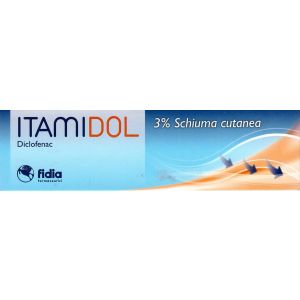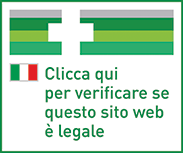Ship in Europe, Find out rates!

Itamidol Skin Foam 3% Diclofenac Joint Pain 50g
Foam based on diclofenac.
Therapeutic indications
Itamidol Foam is used in the local treatment of painful and inflammatory conditions of a rheumatic or traumatic nature of the joints, muscles, tendons and ligaments.
Dosage and Posology
The drug should be taken according to the following doses and methods:
- Adults over 18 years Apply Itamidol 3% skin foam 1-3 times a day or according to medical prescription. For each application, spray on the palm of the hand, depending on the size of the area to be treated, a circular mass of foam of 3-5 centimeters in diameter (equal to about 0.75-1.5 grams in weight), massaging gently until completely absorption. In case of iontophoresis treatment, the product must be applied to the negative pole. Itamidol 3% skin foam can also be used in combination with ultrasound therapy. After application, wash your hands, otherwise they will also be treated with the skin foam Warning: use only for short periods of treatment
- Teenagers from 14 to 18 years: Apply Itamidol 3% skin foam 1-3 times a day or according to medical prescription. For each application, spray on the palm of the hand, depending on the size of the area to be treated, a circular mass of foam of 3-5 centimeters in diameter (equal to about 0.75-1.5 grams in weight), massaging gently until completely absorption. In case of iontophoresis treatment, the product must be applied to the negative pole. Itamidol 3% skin foam can also be used in combination with ultrasound therapy. After application, wash your hands, otherwise they will also be treated with the skin foam. If this product is needed for more than 7 days to relieve pain or if symptoms worsen, consult a doctor.
- Children below 14 years: Insufficient data are available on efficacy and safety in children and adolescents below 14 years. Therefore the use of Itamidol 3% cutaneous foam is contraindicated in children under 14 years of age.
- Elderly: The usual adult dosage may be used
Shake before using. With the can upside down, dispense the desired quantity by pressing the appropriate dispenser.
Overdose
The low systemic absorption of topical diclofenac makes an overdose very unlikely. However, undesirable effects similar to those seen after an overdose of diclofenac tablets may be expected if topical diclofenac is inadvertently ingested (1 bottle of 50 g of product contains the equivalent of 1.5 g of diclofenac). In the event of accidental ingestion resulting in significant systemic side effects, general therapeutic measures normally taken to treat poisoning with non-steroidal anti-inflammatory drugs should be undertaken. Gastric decontamination and the use of activated charcoal must be considered, especially within a short time of ingestion.
Contraindications
- Hypersensitivity to diclofenac or to any of the excipients. Hypersensitivity to other non-steroidal anti-inflammatory drugs, such as acetylsalicylic acid.
- Patients who have experienced asthma attacks, urticaria or acute rhinitis after taking acetylsalicylic acid or other non-steroidal anti-inflammatory drugs (NSAIDs).
- Hypersensitivity to isopropanol.
- Third trimester of pregnancy
Side effects
The systemic absorption of diclofenac following treatment with Itamidol 3% cutaneous foam is very low and therefore the risk of systemic effects is limited. However, following applications on large skin surfaces for long periods of time, due to the amount of active ingredient that is absorbed, the appearance of undesirable effects, especially at the gastrointestinal level, cannot be excluded. Adverse reactions (Table 1) are listed by frequency, most frequent first, using the following convention: common (≥ 1/100 to <1/10); uncommon (≥ 1 / 1,000 to <1/100); rare (≥ 1 / 10,000, <1 / 1,000); very rare (<1 / 10,000); Not known: cannot be estimated from the available data.
- Disorders of the immune system
- Very rare Hypersensitivity (including urticaria), angioneurotic edema.
- Infections and infestations
- Very rare Rash with pustules
- Respiratory, thoracic and mediastinal disorders
- Very rare Asthma
- Skin and subcutaneous tissue disorders
- Common: Rash, eczema, erythema, dermatitis (including contact dermatitis), pruritus.
- Rare: Bullous dermatitis
- Very rare: Photosensitivity reaction.
The use of the medicine in combination with other medicines containing diclofenac can give rise to skin reactions with severe evolution (Stevens-Johnson syndrome, Lyell's syndrome).
Pregnancy and breastfeeding
The systemic concentration of diclofenac, compared with oral formulations, is lower after topical administration. Referring to experience with NSAID treatment for systemic administration, the following is recommended: Inhibition of prostaglandin synthesis may adversely affect pregnancy and / or embryo / fetal development. Results of epidemiological studies suggest an increased risk of miscarriage and cardiac malformation and gastroschisis after use of a prostaglandin synthesis inhibitor in early pregnancy. The absolute risk of cardiac malformations increased from less than 1% to approximately 1.5%. The risk was believed to increase with dose and duration of therapy. In animals, administration of prostaglandin synthesis inhibitors has been shown to cause increased pre- and post-implantation loss and embryo-fetal mortality.
In addition, an increased incidence of various malformations, including cardiovascular, has been reported in animals administered prostaglandin synthesis inhibitors during the organogenetic period. During the first and second trimester of pregnancy, diclofenac should not be administered except in strictly necessary cases. If diclofenac is used by a woman attempting to conceive, or during the first and second trimester of pregnancy, the dose should be kept as low as possible and the duration of treatment as short as possible. During the third trimester of pregnancy, all prostaglandin synthesis inhibitors can expose the fetus to: - cardiopulmonary toxicity (with premature closure of the arterial duct and pulmonary hypertension); - renal dysfunction, which can progress to renal failure with oligo-hydroamnios; the mother and the newborn, at the end of pregnancy, to: - possible prolongation of the bleeding time, and antiplatelet effect which can occur even at very low doses; - inhibition of uterine contractions resulting in delayed or prolonged labor. Consequently, diclofenac is contraindicated during the third trimester of pregnancy.
Like other NSAIDs, diclofenac passes into breast milk in small amounts. However, at therapeutic doses of Itamidol 3% cutaneous foam no effects on the infant are expected. Due to the lack of controlled studies in breastfeeding women, the product should only be used during breastfeeding under the advice of a healthcare professional. In this circumstance, Itamidol 3% cutaneous foam should not be applied to the breasts of nursing mothers, nor elsewhere on large areas of skin or for an extended period of time.
Special warnings
The possibility of systemic adverse events with the application of topical diclofenac cannot be excluded if the preparation is used on large skin areas and for a prolonged period (see summary of product characteristics of systemic forms of diclofenac). Topical diclofenac should only be applied to intact, non-diseased skin, and not to skin wounds or open lesions. It should not be allowed to come into contact with eyes or mucous membranes and should not be ingested.
The concomitant use of systemic anti-inflammatory drugs is not recommended in elderly and / or gastric patients. Patients with asthma, chronic obstructive diseases of the bronchi, allergic rhinitis or inflammation of the nasal mucosa (nasal polyp) react with asthma attacks, local inflammation of the skin or mucosa (Quincke's edema) or urticaria to antirheumatic treatment with NSAIDs more often than other patients. To reduce any phenomena of photosensitization it is advisable not to expose yourself to the sun during use. Keep this medicine out of the reach and sight of children. The administration of Itamidol 3% cutaneous foam should be discontinued in women who have fertility problems or who are undergoing fertility investigations. The use of Itamidol 3% cutaneous foam, especially if prolonged, can give rise to local sensitization phenomena, which require the interruption of the treatment and the adoption of adequate therapeutic measures. Discontinue treatment if skin rash develops after application of the product and consult your doctor. Topical diclofenac can be used with non-occlusive dressings, but should not be used with an occlusive dressing that does not allow air to pass.
Expiry and retention
Check the expiration date indicated on the package. The expiry date indicated on the package refers to the product in intact packaging, correctly stored. Store below 30 ° C. Pressurized container: Itamidol 3% skin foam contains flammable propellant. Protect from sunlight and do not expose to temperatures exceeding 50 ° C. Keep away from any source of combustion.
Warning : do not use the medicine after the expiry date indicated on the package.
Composition
100 gr of Itamidol Foam contain:
Active principle
Diclofenac 3 g
Excipients
Sodium hydroxide; caprilocapric macrogolglycerides; hydrogenated soy lecithin; polysorbate 80; benzyl alcohol; potassium sorbate; disodium phosphate dodecahydrate; all-rac-α-tocopheryl acetate; mint / eucalyptus fragrance; purified water.
Each pressurized container (50 g) contains: 47.5 g of solution and 2.5 g of propellant (isobutane; n-butane; propane).
| Destination | Cost | Detail |
|---|---|---|
| Italy | €5,90* | 24/72H |
| Austria, France, Germany, Slovenia | € 13* | 3 days |
| Belgium, Luxembourg, Portugal, Netherlands, Spain | € 14* | 4 days |
| Bulgary, Cechia, Hungary, Poland, Romania, Slovakia | € 19* | 5 days |
| Denmark, Estonia, Finland, Ireland, Lithuania, Latvia ,Sweden | € 22* | 5 days |
| United Kingdom, Switzerland, Greece | € 30* | 7 days |
| Canada, USA | € 40 | 7 Days |
European shipments with express courier: FedEx, MBE, DHL
*For the shipment outside band B ther's an extra cost of 22€ *For the shipment outside band C ther's an extra cost of 30€ Delivery Times exclude Saturday and Holidays
For Islands and Areas of difficult Accessibility the shipments are made in 72 hours and the cost will be increased by 15€
